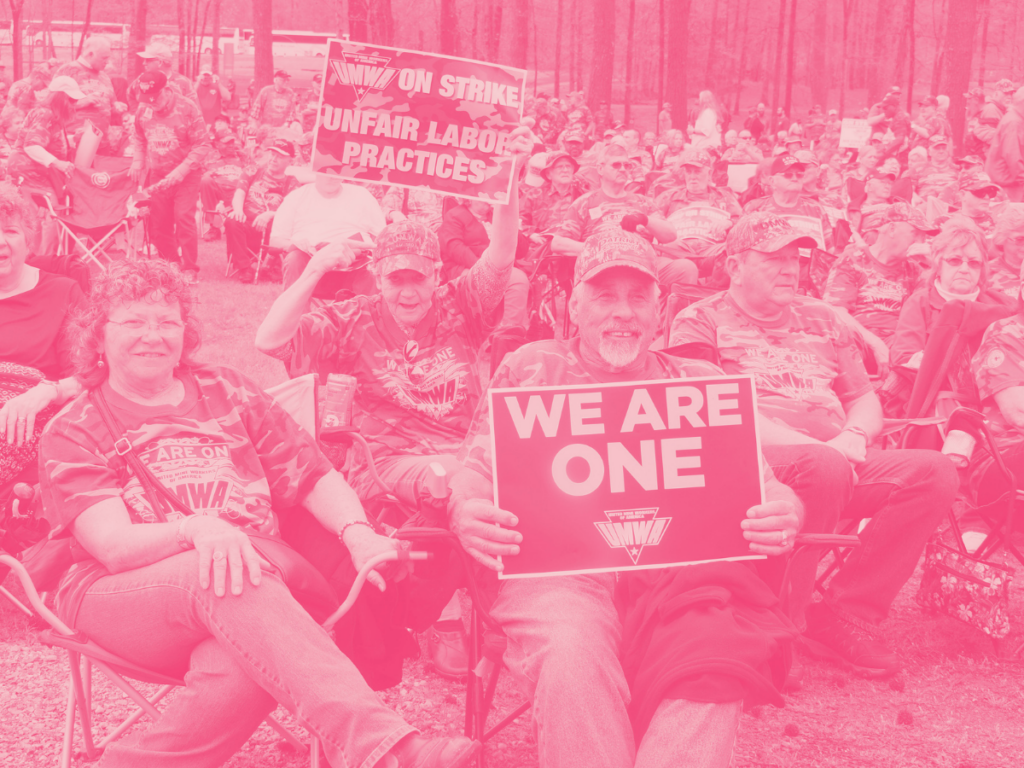At the end of 2020, I decided to begin a new project, chronicling as much as I could of US union activity on a weekly basis, and sharing it, without too much in the way of analysis or commentary. I called it “Who Gets the Bird?” after the famous John Lewis quote on the role of the Left in the CIO organizing of the 1930s: “Who gets the bird, the hunter or the dog?” Part of it was about helping the broader Left better understand actually-existing unions, thus the title. It started as a place for my stray thoughts on the internal politics of the labor movement, but quickly became primarily focused on the regular “The week in US unions” updates.
The newsletter’s most direct inspiration was the work of Derek Davison, behind the Foreign Exchanges newsletter (formerly known as “And That’s the Way It Was”), an incredible project that aggregates global news on a daily basis, broken out by country, into digestible bits for someone who is not an expert or all that familiar with, say, the domestic politics of West Africa. I was taken by the way in which a digest of disparate events could serve as a political education project, both by providing new threads of information that readers could then explore, and more importantly by drawing something like a real-time picture of what actually-existing unions actually do.
Part of it had no doubt to do with my prior habit of tracking this stuff, particularly while working on the Bernie Sanders 2020 campaign, I became meticulous about tracking strike activity, or potential strike activity, that the campaign might support. This would lead to “solidarity actions” where the campaign would text Bernie supporters to get out to a picket line. There wasn’t any straight line from that activity to knocking on doors for the campaign, but it was a core piece of the identity of the campaign, and has remained a part of what Bernie has kept doing after the campaign has ended.
Beyond foundation myths
But it also was about intervening in how the activist Left, or even the self-conscious labor Left, thinks about the labor movement. I have long felt frustrated that the touchstones, the strategic frames, even the images and cultural artifacts, the stories we tell ourselves about our movement, particularly for the labor Left, though also in the activist subculture as a whole, are stuck in a past that very few of us lived through. The general strikes of 1934, the Flint sit-down, Operation Dixie, all the foundation myths of the New Deal-era labor regime inspire or haunt us, and for good reason.
The touchstones, the strategic frames, even the images and cultural artifacts, the stories we tell ourselves about our movement, are stuck in a past that very few of us lived through.
But as a movement trying to get its bearings, trying to find our way out of a decades-long decline (that at this point I would argue is not necessarily a decline so much as the long tail of a movement that peaked 40 to 75 years ago), these foundation myths are not very useful, and often distracting, and so laden with interpretation and political legacy as to be deployed more like shibboleths than something to learn from. Even the “contemporary” updates to understanding the union movement often treat PATCO and the 1980s as the end of the line. As Tom Geoghegan wrote while I was still in diapers, “The other day, I saw a friend, a journalist, who used to write about labor. Now he writes about something else. He said, ‘A few years ago, when labor was dying, that was interesting. But now it’s dead, and it’s been dead. People want to hear about something else.’”
So I wanted to look a dead thing in the eye. Because there is ultimately still much alive in the labor movement. I am against boosterism; the point of the newsletter is not to say “look how much good is happening!” But it is to say there is still much happening. There is a working class, and workers still organize themselves into institutions—often rusted, confused institutions but institutions nonetheless—and those institutions still wield something like power —often defensively, clumsily, often at odds with one another, but they wield it.
If there is a premise the newsletter starts from, it is something like defeat; the unions are still with us, and have an uneven level of life to them, but unionism as a self-conscious social force has to some large extent been dismantled. The Left of yore had to struggle with strategic questions of what should the unions do with all their power and base? Today, the Left begins with the reality that that power has been almost catastrophically eroded, and the unions’ capacity to act has been severely weakened.
If we accept that the institutional labor movement was spiritually defeated (whether you want to say it happened the moment they signed the Wagner Act, or the Taft-Hartley Act, or fired all the air traffic controllers, or passed NAFTA), our task changes. It becomes about some basic level of class formation. How do we take hollowed-out institutions, and a large but only partially self-conscious base of millions of workers, and turn them into a proper movement? The Left speaks often of class struggle, or class war, often with an eye towards what we’d like the working class to achieve through the fight. But as important as what is won is what happens to the working class through the experience of fighting.
‘What union members do still matters’
If you believe, like I do, that class formation depends on the building of mass consciousness, and that consciousness is built through the experience of collective struggle, and that the experience of collective struggle is rare but found most prevalently in the institutional union movement, still, with all its weakness, then union members become the base from which to build. What union members do still matters. Not for the most part because they wield enough force to change the conditions of the economy, but because the unions are positioned to put the most people into some form of collective motion around class interests, which is a necessary precondition for any sort of broader class politics.
But as important as what is won is what happens to the working class through the experience of fighting.
Another project that started in 2021, the Cornell ILR Labor Action Tracker, just released their first annual report on strike activity, the most comprehensive public resource available. They showed that in 2021, 140,000 participated in 265 work stoppages. These fights, for all their diversity and unevenness, for their participants and supporters, are in some ways the sharpest skirmishes that define the actual shape of the class struggle, and that forge lifelong class fighters.
Obviously the newsletter is no means by which to enact this class formative process. I am a cheerleader on the sidelines, keeping the crowd’s attention while we endure these interminable lulls in institutional class war. If there has been an organizing component, it’s been in cohering a readership of several thousand people on a weekly basis who then share with me, and through the newsletter to an extent with one another, what’s going on in their union, in their city, in their industry. I hear from more people in response to the newsletter directly or on social media about what’s happening in their workplace, what I missed, what sparked their interest, than I ever did before the project began.
I learn of internal union elections that are only known among a small number of union members; of upcoming consequential contract ratification votes and strike authorizations; of the less-mediagenic fights like union raids and contested organizing spaces. I also hear from those on the edges of the union movement, supporters, democratic socialists, former Bernie activists, who go to check out a picket line they found in the newsletter, or try to get their local union to send solidarity on a poorly publicized contract fight in their city or state. Some of this missing connective tissue, the beginning of a shared understanding of what is actually going on, is rebuilt in bits and pieces in the margins of the newsletter.
I’ve also heard from many people saying things like “I’ve never seen a resource like this,” or “I use the newsletter to send updates to my local union about our industry or region.” Cleary it’s fulfilling a function for those union activists who want to know what’s going on beyond their workplace and beyond their union, the good, the bad, and the ugly. I’ve also heard from a few readers who wish there were more commentary or critiques of the raw material I aggregate.
Writing history as it happens
I’m not against such a thing, but I think it of more primary importance that we look the actually-existing labor movement in the eye, make our observations, yes, but always first and foremost understand what is actually happening, not primarily what is wished-for, railed-against, once-was, or could-be. I feel inspired to some extent by Adam Tooze, who writes, in response to criticism that he writes “history in medias res.” I think much of what he writes here undergirds why I attempt to catalog and share what is actually happening, in the wake of so much dismantling of working class structures and labor movement institutions:
“We are thrown into situations. Most of the time they don’t come with instructions. If they do come with instructions we should probably not trust them. We have to perform enquiries to figure out how we got here, what our options are and where we might be headed. To do the work of figuring out our situation we might resort to the tools of social science, like statistics or economic concepts. Political theory may help. But history writing too is part of the effort at rendering our situations more intelligible.”
Featured image: More than 1,000 Alabama members of the United Mine Workers of America have been on strike against Warrior Met Coal for more than a year, seeking a contract that would allow them to recoup concessions they made to help their company after it declared bankruptcy in 2016.
Did you enjoy this article?
We're in the middle of our annual fund drive, and this year we're building our own internal infrastructure for subscriptions, meaning more of every dollar pledged goes to fulfilling our mission. Subscribe today to support our work and be a part of Convergence's next evolution.

